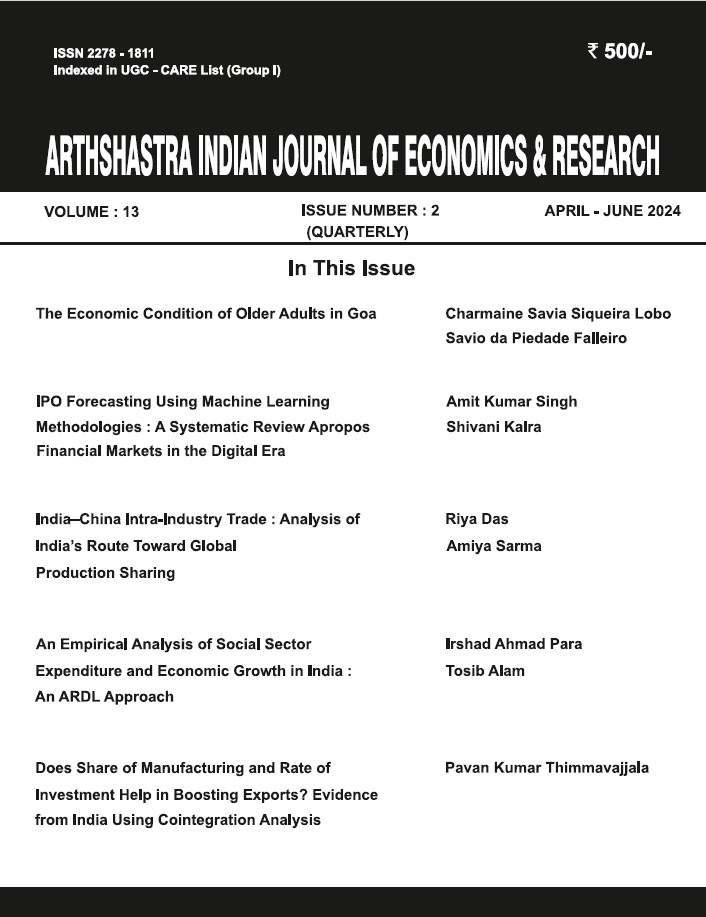Does Share of Manufacturing and Rate of Investment Help in Boosting Exports? Evidence from India Using Cointegration Analysis
DOI:
https://doi.org/10.17010/aijer/2024/v13i2/173505Keywords:
investment
, manufacturing, exports, ARDL cointegration, Granger causality.JEL Classification Codes
, C32, E22, E61, O11Paper Submission Date
, July 25, 2023, Paper sent back for Revision, February 15, 2024, Paper Acceptance Date, March 10, 2024Abstract
Purpose : The current work empirically analyzed the existence of a long-run relationship between India’s rate of exports, its rate of investment, and its share of manufacturing. It also tried to understand the impact investment and manufacturing had on exports. The need to look at India’s exports from the point of its manufacturing capacity necessitated this empirical exercise.
Methodology : The Reserve Bank of India and the World Bank’s data from 1960 to 2020 were used for the analysis. The auto-regressive distributive lag (ARDL) method of cointegration, which was introduced by Pesaran et al. (2001) was utilized to investigate the possibility of a long-term association between the variables. Additionally, the Granger causality test was employed to determine the causal direction of policy effects.
Findings : The ARDL test showed that a long-run relationship existed between India’s rate of exports, rate of investment, and share of manufacturing, wherein the latter positively influenced the rate of exports. This indicates that raising the rate of investment and share of manufacturing would have a multiplier effect on exports.
Practical Implications : From a policy standpoint, the study advocated raising the rate of investment and the share of manufacturing to increase India’s rate of exports. Our study is not free from limitations and allows scope for future researchers to touch upon the kind of transmission.
Originality : Prior research looked at the role of exports and imports in growth and linkages between FDI and trade openness. This work attempted to understand how the level of manufacturing and rate of investment influenced India’s rate of exports.
Downloads
Downloads
Published
How to Cite
Issue
Section
References
Bakari, S., Fakraoui, N., & Tiba, S. (2019). Domestic investment, export, import and economic growth in Brazil: An application of vector error correction model [MPRA Paper No. 95528]. Munich Personal RePEc Archive. https://mpra.ub.unimuenchen. de/95528/1/MPRA_paper_95528.pdf
Bal, D. P., Dash, D. P., & Subhasish, B. (2016). The effects of capital formation on economic growth in India: Evidence from ARDL-bound testing approach. Global Business Review, 17(6), 1388–1400. https://doi.org/10.1177/0972150916660403
Belloumi, M. (2014). The relationship between trade, FDI and economic growth in Tunisia: An application of the autoregressive distributed lag model. Economic Systems, 38(2), 269–287. https://doi.org/10.1016/j.ecosys.2013.09.002
Felipe, J., Kumar, U., & Abdon, A. (2013). Exports, capabilities, and industrial policy in India. Journal of Comparative Economics, 41(3), 939–956. https://doi.org/10.1016/j.jce.2013.01.001
Kumari, D., & Malhotra, N. (2015). Export and economic growth in select South Asian countries: Causality analysis based on Granger test & VECM. Arthshastra Indian Journal of Economics & Research, 4(4), 21–36. https://doi.org/10.17010/aijer/2015/v4i4/77668
Lokanathan, P. S. (1945). The Bombay plan. Foreign Affairs, 23(4), 680–686. https://doi.org/10.2307/20029933
Pesaran, M. H., Shin, Y., & Smith, R. J. (2001). Bounds testing approaches to the analysis of level relationships. Journal of Applied Economics, 16(3), 289–326.
Raghutla, C., & Chittedi, K. R. (2020). Is there an export- or import-led growth in emerging countries? A case of BRICS countries. Journal of Public Affairs, 20(3), e2074. https://doi.org/10.1002/pa.2074
Raghutla, C., Sampath, T., & Chittedi, K. R. (2018). Financial development, trade openness and growth in India. Theoretical and Applied Economics, 25(1), 113–124. https://store.ectap.ro/articole/1323.pdf
Saikia, K. K. (2013). India's export performance and its determinants: An ARDL bounds testing approach. Indian Journal of Finance, 7(10), 25–33. https://www.indianjournaloffinance.co.in/index.php/IJF/article/view/72079






